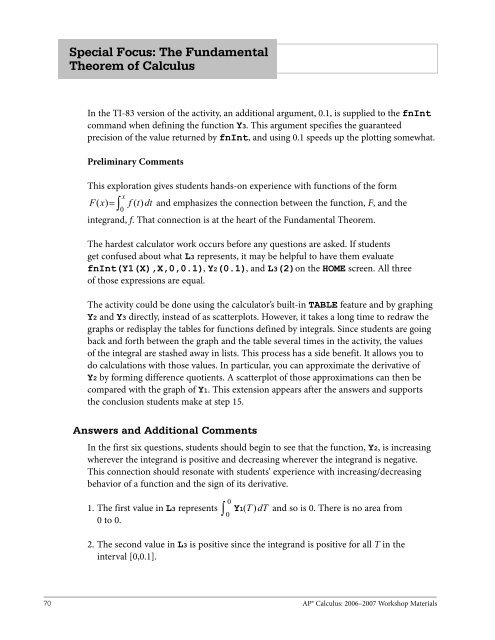AP Calculus
Create successful ePaper yourself
Turn your PDF publications into a flip-book with our unique Google optimized e-Paper software.
Special Focus: The Fundamental<br />
Theorem of <strong>Calculus</strong><br />
In the TI-83 version of the activity, an additional argument, 0.1, is supplied to the fnInt<br />
command when defining the function Y3. This argument specifies the guaranteed<br />
precision of the value returned by fnInt, and using 0.1 speeds up the plotting somewhat.<br />
Preliminary Comments<br />
This exploration gives students hands-on experience with functions of the form<br />
x<br />
F( x) = ∫ f ( t)<br />
dt and emphasizes the connection between the function, F, and the<br />
0<br />
integrand, f. That connection is at the heart of the Fundamental Theorem.<br />
The hardest calculator work occurs before any questions are asked. If students<br />
get confused about what L3 represents, it may be helpful to have them evaluate<br />
fnInt(Y1(X),X,0,0.1), Y2(0.1), and L3(2)on the HOME screen. All three<br />
of those expressions are equal.<br />
The activity could be done using the calculator’s built-in TABLE feature and by graphing<br />
Y2 and Y3 directly, instead of as scatterplots. However, it takes a long time to redraw the<br />
graphs or redisplay the tables for functions defined by integrals. Since students are going<br />
back and forth between the graph and the table several times in the activity, the values<br />
of the integral are stashed away in lists. This process has a side benefit. It allows you to<br />
do calculations with those values. In particular, you can approximate the derivative of<br />
Y2 by forming difference quotients. A scatterplot of those approximations can then be<br />
compared with the graph of Y1. This extension appears after the answers and supports<br />
the conclusion students make at step 15.<br />
Answers and Additional Comments<br />
In the first six questions, students should begin to see that the function, Y2, is increasing<br />
wherever the integrand is positive and decreasing wherever the integrand is negative.<br />
This connection should resonate with students’ experience with increasing/decreasing<br />
behavior of a function and the sign of its derivative.<br />
0<br />
1. The first value in L3 represents ∫ Y1( T ) dT and so is 0. There is no area from<br />
0<br />
0 to 0.<br />
2. The second value in L3 is positive since the integrand is positive for all T in the<br />
interval [0,0.1].<br />
70<br />
<strong>AP</strong>® <strong>Calculus</strong>: 2006–2007 Workshop Materials


